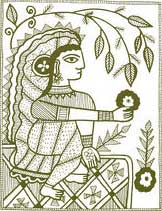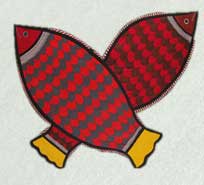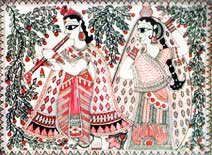Home >
Arts > Paintings > Madhubani Paintings
Madhubani Painting is very much a famous traditional art form done by women in the villages of Madhubani and Mithila in the state of Bihar . Madhubani Paintings are basically done on various mediums such as cloth, hand made paper and canvas. Madhubani paintings are the art form which depict the various elements in nature and Hindu religious motifs and the scripts mostly revolve around the Hindu deities like Krishna, Ram, Shiva, Durga, Lakshmi and Saraswati.
There are even paintingsof natural objects like the sun, the moon and religious plants like tulsi which are widely painted as also royal courts and social events like weddings.

Some of the famous and common Madhubani paintings as part of wall hanging frames include:
Suga Parrots ,Stories Of Panchatantra, Flower Valley, Jungle Friends ,Monkey And The Crocodile ,Ganapati Playing Tabla Or Marriage Proposal , The Goan Fish Kohbar, The Owl , Krishna With Gopis, Krishna And Radha,, Fishes And The Girl, Kaalia Black And White Theme , Mardan, The Snake Goddess, Goan Fishes, The Champa Tree, The Horses, The Dancing Girls and the Four Turtles.

The art of Madhubani painting requires skill and implies very much certain technique.
• First, cotton is wrapped around a bamboo stick to make it like a brush.
• The colours are then applied flat with no shading .
• A double line is then drawn to from the outlines of the paintings.
• Gaps between the lines are filled by cross or straight tiny lines.
• Colours are not applied in linear paintings, only outlines are drawn.

• The black colour which is obtained from blending soot and cow dung.
• Yellow is prepared normally from turmeric, pollen, lime, milk of banyan leaves,
• Blue from indigo
• Red from the kusam flower juice or red sandalwood
• Green from the leaves of wood apple tree
• White is acquired from rice powder
• Orange from palasha flowers


